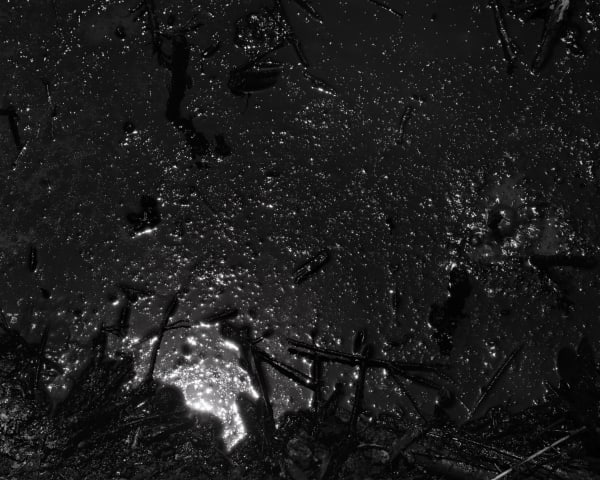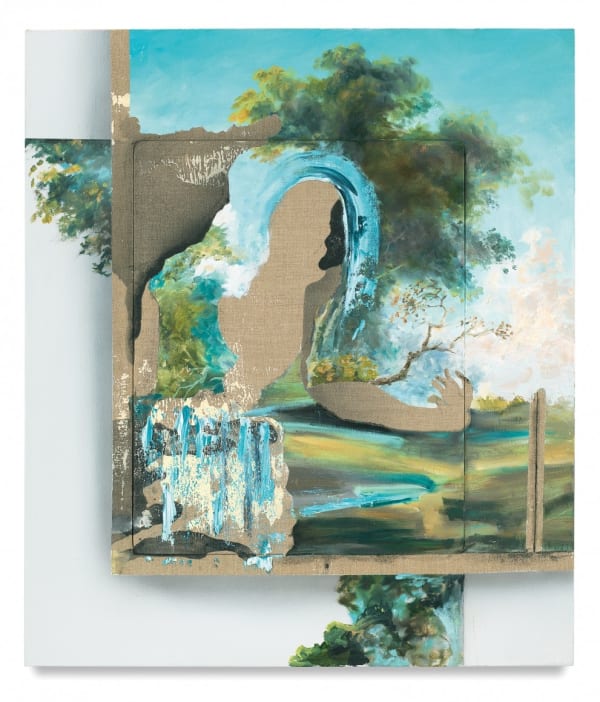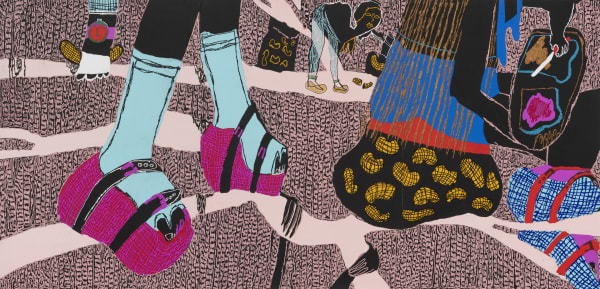Hold on Tight
Shulamit Nazarian is pleased to present Hold on Tight, an exhibition of works by Annie Lapin, Mark McKnight, Naudline Pierre, Fay Ray, Michael Stamm, Cammie Staros, Summer Wheat and Wendy White.
Our current moment is filled with uncertainty. Much of our daily life is now encompassed by a sense of precariousness and anxiety, yet we find solace in the small pleasures of quotidian moments. The artworks in this exhibition navigate the complex relationships between these emotions: the desire for touch and connection through isolation and our longing for the people and places that have recently been out of reach. Together, these works highlight the existential task of finding hope through seclusion, vulnerability, and possibility.
In this exhibition, Fay Ray continues her exploration of female identity, body adornments, and fetishized objects. The artist compiles visually embellished sculptures that often resemble over-sized charms and pendants, subverting their functionality and shrinking the sense of the viewer's body by the scale and weight of the materials used. In a new sculpture titled Guardian, the work bears semblance to pendants found at desert flea markets; crystals or small stones wrapped in wire and in the form of a peace sign. Simultaneously, they are pulled into the realm of capable and meaningful violence. Guardian is bound; both by the chains to the wall, and by the bondage of its own ceasefire symbolism. Situated by the gallery’s glass facade, the pendants embody their true functionality as one of possible destruction. The rock becomes still, unmoving, but not empty of its potential to break through.
The emotional state of longing and desire permeates Mark McKnight’s silver gelatin prints, which often portray the bodies of queer friends and lovers. McKnight carefully depicts the effects of entropy on the human form and draws an analogous connection with scars found on architecture, urban spaces, and the landscape. The results are formal images that are equally tender and brutal. The photograph Bodyfold, depicts a man’s body tightly cropped and partially obscured. The body subtly contorts to appear as if part of a larger landscape. In the upper left corner is a faint crack in the pavement, evoking the vulnerability of the body itself. McKnight’s photographs elicit a desire for intimate touch across a jagged ravine—implying an erotic, yet merciless, psychological space.
Looking specifically to the shapely vessels of Classical Greece, Cammie Staros’ hand-built objects marry ancient ceramic techniques with contemporary forms. Using references to desire, eroticism, and violence within artifacts from Western Art History, the works allow for a reexamination of the role of historical objects. As seen in Coaxed Into and Out of It, carved wood takes on the form of two arms, modeled after the artist’s own body. Reaching out from the walls in a gesture to make physical connection, one arm subtly shifts into the form of a snake. Just below, is an elongated ceramic vessel with the form and surface pattern that visually references the arm above. Snakes, a symbol of birth and healing, as well as a possible hazard, are combined with a domestic vessel, providing a cautionary message that links the intimacy of home with the dangers of the outside world.
Annie Lapin’s paintings reside in a fracturing world, one that seems to push forward and backwards out of the frame simultaneously. Within her works, digital histories and analog mark making come together to form trompe l’oeil scenes that abide neither to the rules of the virtual nor to the physical. In her recent painting Event, made during the COVID-19 quarantine, Lapin merges references to the body as a form of rupture in her pictorial planes. This painting makes use of flash photography as a light source to eerily illuminate a curb, foliage, and sky—as if walking in a neighborhood that looks familiar, but somehow isn’t. Floating on the surface of the painting is an ominous single red rose and two outstretched hands, alluding to the desire for access to the outside world.
Michael Stamm’s paintings and drawings critically consider the popular tenets of our time, reconciling hope and skepticism, in an era that straddles both. In Nihilism, a television screen occupies most of the painting, evoking a secluded space filled with pressing static and deafening quiet. Visible noise, also known as TV snow, acts as a mediator between the domestic space and the outside winterscape. The electronic frame becomes a psychological space for longing, a calling for a place out of time, or an escape from the confinement one is currently in. In Causes, cramped text that reads “causes cause causes to cause causes” overlays an image of an antacid being stirred into a glass of water. The repetition of the text suggests a distressed mantra, while the ‘remedy’ in the painting functions as a real neutralizer for symptoms related to anxiety. Like the spinning of the spoon, one can imagine the phrase circling around in the mind.
Many of the paintings and sculptures by Wendy White serve as cultural critique that offers a glimmer of hope. Employing language and aesthetics often related to male-dominated areas, from Abstract Expressionism to the machismo of cigarette ads, the artist asks us to reconsider American myths and symbols of the sublime. In Uncontained (Orange with Cloud and Rainbow), a continuation of earlier work using gestural mark-making, depicts a mostly dark, abstract field drained of color. The rainbow, a cultural symbol of optimism, becomes black, cold, and industrial. Holding these dichotomies of fulfillment and emptiness in the same space is also apparent in Pleasure! (with drip). These coded works point to a troubled cultural past that continues to inform our present, allowing us to get a glimpse of a more hopeful future.
Caught between the beautiful and the haunting, Naudline Pierre’s paintings depict intimate, otherworldly scenes in which her central protagonist, a twin for the artist, resides in an unstable, hypnotic and alternative world. Many of Pierre’s works serve as portals; they summon a bottomless, swaying space where figures appear and disappear. Finding this subject in moments of embrace, she gains protection and healing with the touch of adjacent beings—these figures attempt to ground the protagonist. In the painting Eye See, gravity is unclear, as several figures seem to hover; an intimate touch to the forehead of the main subject renders her motionless, while still fully aware of her surroundings.
This sense of limbo can also be found in Summer Wheat’s textural art objects, which destabilize material boundaries and elevate quotidian life. In Midnight Snack, Wheat references Gustave Courbet’s epochal Stonebreakers (1848), a controversial painting that depicts laborers participating in back breaking work, paying no attention to the viewer. Similar in composition and anonymity, Midnight Snack replaces the stonebreakers with unknown female figures, memorializing the fleeting moment of the domestic work-break. In this dreamy hour, one would find themselves gathering midnight snacks, residing in a liminal space between day and night, wake and sleep. The figures in the work are also walking on branches, precariously balancing themselves in an unstable space. In Wheat’s works on paper, Angel Hair, Pills, and Oranges, the artist takes banal slices of the everyday with a moment of anxious pause. These seemingly quotidian scenes are rendered with a sense of quiet pleasure, focusing on the familiar in a time of uncertainty.
-
 Fay RayGoya's Kitchen I, 2020Bass wood38 x 7.5 x 2 inches
Fay RayGoya's Kitchen I, 2020Bass wood38 x 7.5 x 2 inches -
 Fay RayGoya's Kitchen II, 2020Bass wood35 x 15 x 2 inches
Fay RayGoya's Kitchen II, 2020Bass wood35 x 15 x 2 inches -
 Fay Ray, Guardian, 2020
Fay Ray, Guardian, 2020 -
 Fay RayGuardian, 2020Granite and steel25 x 58 x 39 inches
Fay RayGuardian, 2020Granite and steel25 x 58 x 39 inches -
 Mark McKnightSpinning Away, 2018Gelatin Silver Print, framed with Optium Plexi30 x 24 inches1 of 3 + 2AP
Mark McKnightSpinning Away, 2018Gelatin Silver Print, framed with Optium Plexi30 x 24 inches1 of 3 + 2AP -
 Mark McKnight, Flesh, 2018
Mark McKnight, Flesh, 2018 -
 Mark McKnight, Eros (& Erosion), 2018
Mark McKnight, Eros (& Erosion), 2018 -
 Mark McKnight, Destructive Distillation (Tar Cosmos), 2018
Mark McKnight, Destructive Distillation (Tar Cosmos), 2018 -
 Mark McKnight, Bodyfold, 2019
Mark McKnight, Bodyfold, 2019 -
 Cammie StarosCoaxed Into and Out of It, 2022Ceramic and walnut36 x 18 x 17 in
Cammie StarosCoaxed Into and Out of It, 2022Ceramic and walnut36 x 18 x 17 in
91.4 x 45.7 x 43.2 cm -
 Naudline PierreEye See, 2017Oil and enamel on canvas40 x 26 inches
Naudline PierreEye See, 2017Oil and enamel on canvas40 x 26 inches -
 Annie Lapin, Event, 2020
Annie Lapin, Event, 2020 -
 Wendy White, Pleasure! (with drop), 2017
Wendy White, Pleasure! (with drop), 2017 -
 Annie Lapin, Stop Calling, 2018
Annie Lapin, Stop Calling, 2018 -
 Annie Lapin, To Sit and Think, 2018
Annie Lapin, To Sit and Think, 2018 -
 Summer Wheat, Midnight Snack, 2019
Summer Wheat, Midnight Snack, 2019 -
 Summer WheatAngel Hair, 2017Pen and ink on paper11 x 14 inches
Summer WheatAngel Hair, 2017Pen and ink on paper11 x 14 inches -
 Summer Wheat, Oranges, 2017
Summer Wheat, Oranges, 2017 -
 Summer WheatPills, 2017Pen and ink on paper11 x 14 inches
Summer WheatPills, 2017Pen and ink on paper11 x 14 inches -
 Michael StammCauses, 2018Oil and acrylic on canvas48 x 36 inches
Michael StammCauses, 2018Oil and acrylic on canvas48 x 36 inches -
 Michael Stamm, Nihilism, 2012
Michael Stamm, Nihilism, 2012 -
 Wendy WhiteUncontained (Pixel Heart), 2020Acrylic on canvas, PVC and plexiglas artist's frame39.5 x 52 inches
Wendy WhiteUncontained (Pixel Heart), 2020Acrylic on canvas, PVC and plexiglas artist's frame39.5 x 52 inches -
 Wendy WhiteUncontained (Orange with Cloud and Rainbow), 2020Acrylic on canvas, PVC and plexiglas artist's frame46 x 44.25 inches
Wendy WhiteUncontained (Orange with Cloud and Rainbow), 2020Acrylic on canvas, PVC and plexiglas artist's frame46 x 44.25 inches


































